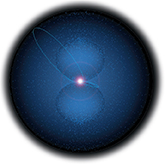Comets and Meteoroids
As the craters on the surfaces of the terrestrial planets and moons show, there are many smaller objects moving through the inner solar system. These objects take two forms: comets and meteoroids.  Comets are dusty pieces of ice and rock that partially vaporize when they pass near the sun. Meteoroids are pieces of rock, usually less than a few hundred meters in size, that travel through the solar system.
Comets are dusty pieces of ice and rock that partially vaporize when they pass near the sun. Meteoroids are pieces of rock, usually less than a few hundred meters in size, that travel through the solar system.
Certain ancient meteoroids have been largely unaltered since the birth of the solar system. These meteoroids are the oldest remnants of the early solar system. Scientists have used radioactive dating to determine their absolute age. This has allowed them to determine that the solar system is about 4.6 billion years old.
The Edge of the Solar System
Astronomers estimate that thousands of solar system objects exist beyond Neptune's orbit. These objects are found largely in two regions, the Kuiper belt and the Oort cloud. The Kuiper belt extends from Neptune's orbit out to about 100 AU or more from the sun. Objects in the Kuiper belt are mostly made of ice, dust, and rock.  Most of the objects in the Kuiper belt lie in a doughnut-shaped region close to the ecliptic. Pluto is an example of a Kuiper‒belt object.
Most of the objects in the Kuiper belt lie in a doughnut-shaped region close to the ecliptic. Pluto is an example of a Kuiper‒belt object.
Incredible as it may seem, the solar system extends much farther out than the Kuiper belt.  Beyond the Kuiper belt lies a great reservoir of comets called the Oort cloud. Figure 27 shows the Oort Cloud, a very sparse sphere of comets thought to encircle the solar system out to a distance of about 50,000 AU. Occasionally objects from the Oort cloud enter the inner solar system, where they appear as comets.
Beyond the Kuiper belt lies a great reservoir of comets called the Oort cloud. Figure 27 shows the Oort Cloud, a very sparse sphere of comets thought to encircle the solar system out to a distance of about 50,000 AU. Occasionally objects from the Oort cloud enter the inner solar system, where they appear as comets.
Figure 27 Located in the outer reaches of the solar system, the Oort cloud is a sphere of comets surrounding the sun and planets.

25.4 Assessment
Reviewing Concepts
 How do the size and density of the gas giants from the terrestrial planets?
How do the size and density of the gas giants from the terrestrial planets? Name the outer planets and identify a distinguishing characteristic for each.
Name the outer planets and identify a distinguishing characteristic for each. How are planets and dwarf planets similar? How are they different?
How are planets and dwarf planets similar? How are they different? Compare and contrast comets and meteoroids.
Compare and contrast comets and meteoroids. What are some differences between the Kuiper belt and the Oort cloud?
What are some differences between the Kuiper belt and the Oort cloud?
Critical Thinking
Inferring Why might the gas giants be more appropriately called the “liquid giants”?
Comparing and Contrasting How are Jupiter's four large moons similar? How are they different?
Connecting Concepts
The Scientific Method Write a paragraph explaining how the discoveries of Uranus and Neptune show two different aspects of the process of scientific discovery.




